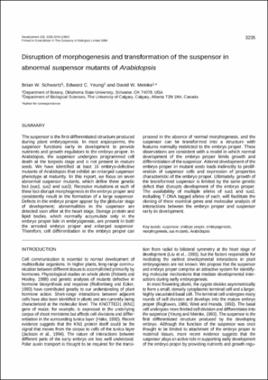| dc.contributor.author | Schwartz, Brian W. | |
| dc.contributor.author | Yeung, Edward C. | |
| dc.contributor.author | Meinke, David W. | |
| dc.date.accessioned | 2019-08-22T17:51:03Z | |
| dc.date.available | 2019-08-22T17:51:03Z | |
| dc.date.issued | 1994 | |
| dc.identifier | oksd_b.w.schwartz_disruptionofmor_1994 | |
| dc.identifier.citation | Schwartz, B. W., Yeung, E. C., & Meinke, D. W. (1994). Disruption of morphogenesis and transformation of the suspensor in abnormal suspensor mutants of Arabidopsis. Development, 120(11), 3235-3245. | |
| dc.identifier.uri | https://hdl.handle.net/11244/321265 | |
| dc.description.abstract | The suspensor is the first differentiated structure produced during plant embryogenesis. In most angiosperms, the suspensor functions early in development to provide nutrients and growth regulators to the embryo proper. In Arabidopsis, the suspensor undergoes programmed cell death at the torpedo stage and is not present in mature seeds. We have identified at least 16 embryo-defective mutants of Arabidopsis that exhibit an enlarged suspensor phenotype at maturity. In this report, we focus on seven abnormal suspensor mutants, which define three genetic loci (sus1, sus2 and sus3). Recessive mutations at each of these loci disrupt morphogenesis in the embryo proper and consistently result in the formation of a large suspensor. Defects in the embryo proper appear by the globular stage of development; abnormalities in the suspensor are detected soon after at the heart stage. Storage protein and lipid bodies, which normally accumulate only in the embryo proper late in embryogenesis, are present in both the arrested embryo proper and enlarged suspensor. Therefore, cell differentiation in the embryo proper can proceed in the absence of normal morphogenesis, and the suspensor can be transformed into a structure with features normally restricted to the embryo proper. These observations are consistent with a model in which normal development of the embryo proper limits growth and differentiation of the suspensor. Altered development of the embryo proper in mutant seeds leads indirectly to proliferation of suspensor cells and expression of properties characteristic of the embryo proper. Ultimately, growth of the transformed suspensor is limited by the same genetic defect that disrupts development of the embryo proper. The availability of multiple alleles of sus1 and sus2, including T-DNA tagged alleles of each, will facilitate the cloning of these essential genes and molecular analysis of interactions between the embryo proper and suspensor early in development. | |
| dc.format | application/pdf | |
| dc.language | en_US | |
| dc.publisher | Company of Biologists | |
| dc.rights | This material has been previously published. In the Oklahoma State University Library's institutional repository this version is made available through the open access principles and the terms of agreement/consent between the author(s) and the publisher. The permission policy on the use, reproduction or distribution of the material falls under fair use for educational, scholarship, and research purposes. Contact Digital Resources and Discovery Services at lib-dls@okstate.edu or 405-744-9161 for further information. | |
| dc.title | Disruption of morphogenesis and transformation of the suspensor in abnormal suspensor mutants of Arabidopsis | |
| osu.filename | oksd_b.w.schwartz_disruptionofmor_1994.pdf | |
| dc.description.peerreview | Peer reviewed | |
| dc.description.department | Botany | |
| dc.type.genre | Article | |
| dc.type.material | Text | |
| dc.subject.keywords | suspensor | |
| dc.subject.keywords | embryo proper | |
| dc.subject.keywords | embryogenesis | |
| dc.subject.keywords | morphogenesis | |
| dc.subject.keywords | sus mutants | |
| dc.subject.keywords | arabidopsis | |
